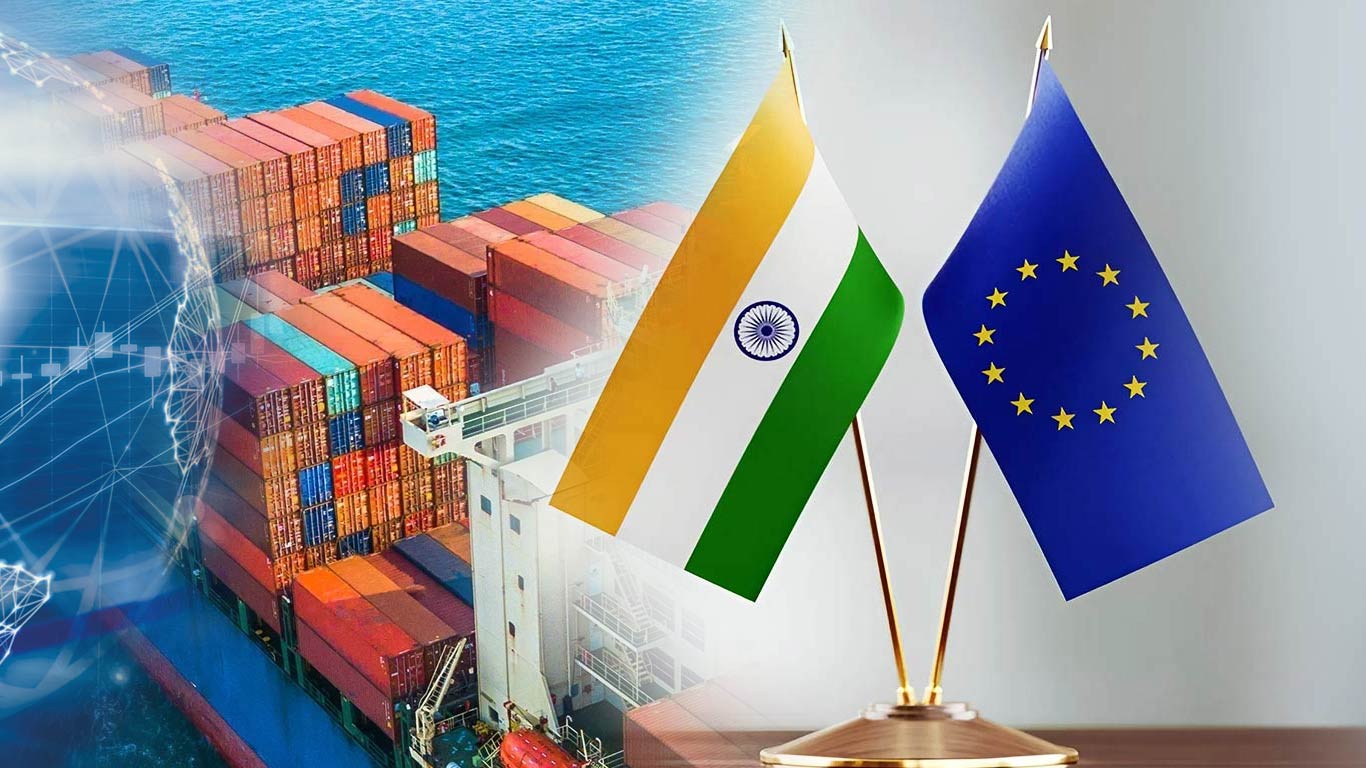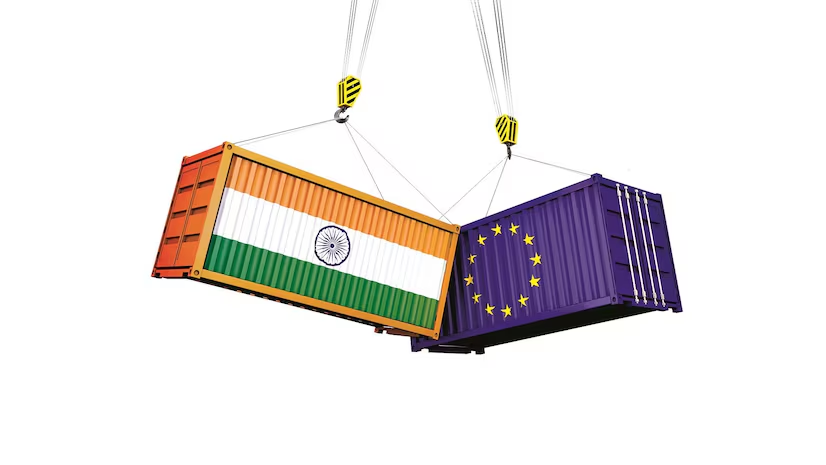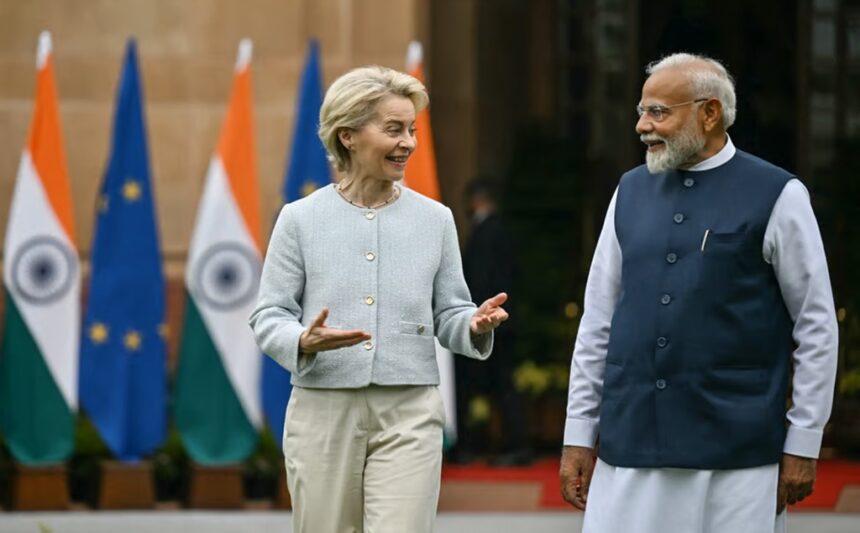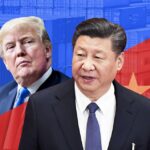India and the European Union (EU) are working toward finalizing a Free Trade Agreement (FTA) by the end of 2025. This effort comes at a time of shifting global economic priorities, driven by geopolitical tensions and rising trade barriers.
If completed, the deal could redefine trade relations between the two regions, providing economic advantages for both while addressing key strategic challenges. India’s growing economy and Europe’s aging population highlight the mutual importance of this agreement.
The EU is India’s largest trading partner, with bilateral trade in goods reaching €124 billion in 2023, about 12.2% of India’s overall trade. Trade in services has also grown significantly, rising from €30.4 billion in 2020 to €59.7 billion in 2023.
On the other hand, India is the EU’s ninth-largest trade partner, representing 2.2% of the bloc’s trade. These numbers underscore the economic potential of an FTA, particularly as Europe addresses labor shortages and India looks to expand its market access.

Negotiations Gain Momentum
Negotiations for the FTA restarted in June 2022 after a decade-long pause. Talks have accelerated in recent months, with both sides aiming to finalize the agreement before the year-end deadline.
European Commission President Ursula von der Leyen described the proposed deal as “the largest of its kind anywhere in the world” during her visit to New Delhi in early 2025. Prime Minister Narendra Modi highlighted the shared values and trust between the two regions as the foundation of their partnership.
The FTA seeks to reduce barriers to trade and investment. The EU is pushing for better access to Indian markets for products like automobiles, alcoholic beverages, and dairy goods, many of which currently face tariffs exceeding 100%. Meanwhile, India wants lower tariffs on exports like textiles, pharmaceuticals, and leather products. Another priority for India is improved visa access for skilled professionals, especially in IT.
However, several challenges remain. India’s agricultural policies, particularly in the dairy sector, and the EU’s stringent environmental rules, including the Carbon Border Adjustment Mechanism (CBAM), have been sticking points in the negotiations. Despite these hurdles, both sides seem committed to finding solutions that work for both their economies.

Addressing Demographic and Strategic Needs
Europe’s aging population presents unique challenges that India could help address. By 2050, the EU’s median age is expected to reach 48, compared to India’s median age of 28. The FTA could make it easier for Indian workers to fill gaps in sectors such as healthcare, technology, and manufacturing, where Europe faces labor shortages.
In return, European investment in India—already at €108.3 billion in 2022—could increase further. This would support initiatives like “Make in India,” aimed at boosting India’s manufacturing capabilities and positioning the country as a global production hub.
Beyond economics, the agreement carries significant geopolitical weight. For Europe, reducing its reliance on China for trade is a key priority. For India, the FTA offers an alternative to aligning with regional trade groups dominated by China. Both sides share a common interest in promoting open trade and reducing reliance on any one nation, especially in an increasingly divided global economy.
Von der Leyen highlighted this shared vision during her trip to India, emphasizing that cooperation is essential to counter isolationist trends. The urgency to finalize the agreement has grown, especially with the U.S. imposing potential tariffs, which could disrupt global supply chains.

India and EU Tariffs
While optimism about the deal is high, several issues still need resolution. India’s high tariffs and the EU’s labor and environmental standards require careful negotiation. Analysts suggest that phased tariff reductions and special provisions for sensitive sectors could help smooth the process. Additionally, separating the FTA from related Investment Protection and Geographical Indications agreements may allow quicker implementation.
If completed, the India-EU FTA could reshape the global trade landscape. For Europe, it offers a way to rejuvenate its workforce and reduce trade dependencies. For India, it provides access to a massive market and resources to drive growth. As the December 2025 deadline approaches, the success of this agreement could mark the beginning of a new era in economic and strategic collaboration between the two regions.
Related News:
American Arrested in India for Visiting Forbidden Island of the Sentinelese People

Geoff Thomas is an award winning journalist known for his sharp insights and no-nonsense reporting style. Over the years he has worked for Reuters and the Canadian Press covering everything from political scandals to human interest stories. He brings a clear and direct approach to his work.














